Big Ben |
|
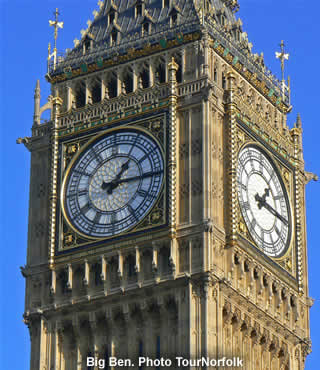 |
|||
One of the world's largest four faced chiming clocks and London's best known landmark |
|||||
Listen to this article |
|||||
|
|||||
Big Ben is one of the world’s largest four faced chiming clocks. It is one of London's best-known landmarks and looks most spectacular at night when the clock faces are illuminated. |
|||||
The tower was part of Charles Barry's design for the new Palace of Westminster, after the old one was destroyed by fire in 1834. Although Barry was the chief architect of the palace, he turned to Augustus Pugin for the design of the clock tower. The design for Big Ben was, in fact, Pugin's last design before his final descent into madness and death. |
|||||
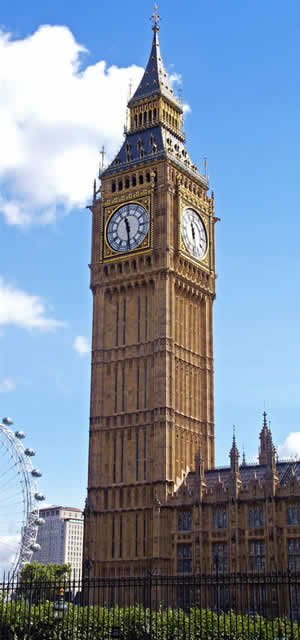 The tower containing Big Ben, 316-feet (96-metres) high Photo dbaron |
|||||
The name Big Ben actually refers not to the clock-tower itself, but to the 13-ton great bell hung inside the tower. The bell was named after the commissioner of works, Sir Benjamin Hall, who was responsible for its casting in 1856 by Warners of Stockton-on-Tees. The bell was ready before the tower and was hung in nearby New Palace Yard. However, the bell cracked by the striking hammer and had to be recast in Whitechapel Bell Foundry. The clock became operational on 7th September 1859. |
|||||
|
|||||
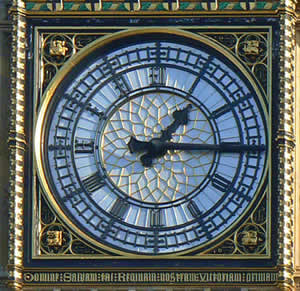 The clock face, 23-feet (7-metres) in diameter. The minute hands are made of copper and the hour hands are made of gunmetal Photo TourNorfolk |
|||||
The clock is famous for its accuracy and reliability, due to the skill of its design. The saying “put a penny on”, meaning slow down, came from the method of fine-tuning the clock's pendulum. The pendulum carries a small stack of old penny coins, adding or subtracting coins has the effect of minutely altering the rate at which the pendulum swings. A single penny will change the clock's speed by 2/5th of a second per day. |
|||||
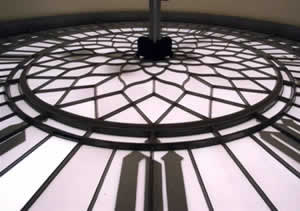 Behind the clockface of Big Ben. The numerals are about half a metre high and there are 312 panes of glass in each of the four faces Parliamentary copyright image and reproduced with the permission of Parliament |
|||||
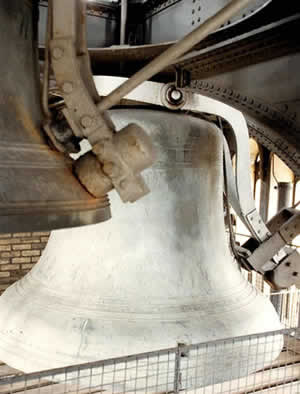 Big Ben - the 13 ton great bell Parliamentary copyright image and reproduced with the permission of Parliament |
|||||
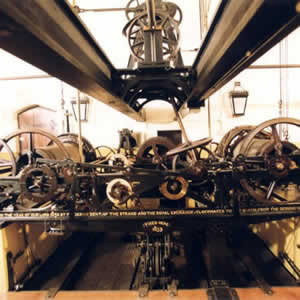 The clock mechanism within the clock tower Parliamentary copyright image and reproduced with the permission of Parliament |
|||||
Despite heavy bombing the clock ran accurately throughout the Blitz of WW2. It slowed down on New Year's Eve 1962 due to heavy snow, causing it to chime in the New Year 10 minutes late. The clock had its first and only major breakdown in 1976. The chiming mechanism broke due to metal fatigue on 5th August of that year, and was repaired by the 9th May 1977. On Friday, 27th May 2005, the clock stopped ticking at 10.07 pm, due to hot weather, as temperatures in London had reached 31.8C or 90F. It resumed keeping time, but stalled again at 10.20 pm and remained still for about 90 minutes before starting up again. |
|||||
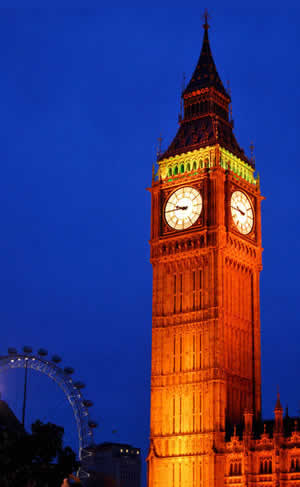 Big Ben illuminated at night Photo pb |
|||||
|
|||||
The clock tower is not open to visitors. Make sure you visit after dark to see the clockface illuminated and visit on the hour to hear the full chimes. |
|||||
|
Pocket Britain is optimised for use on a smartphone or tablet with internet access. All content is subject to copyright. All reasonable methods have been used to ensure information supplied is accurate at the time of publication. However, it is advisable to check information before relying on it. Privacy Policy |